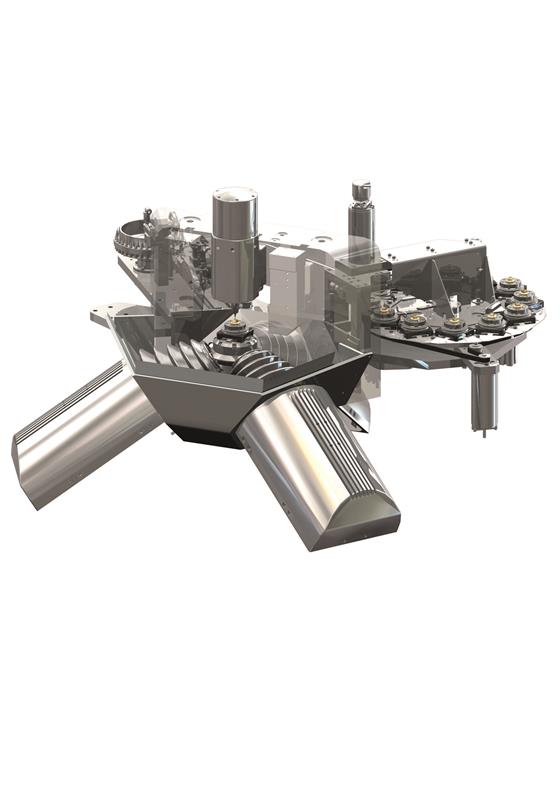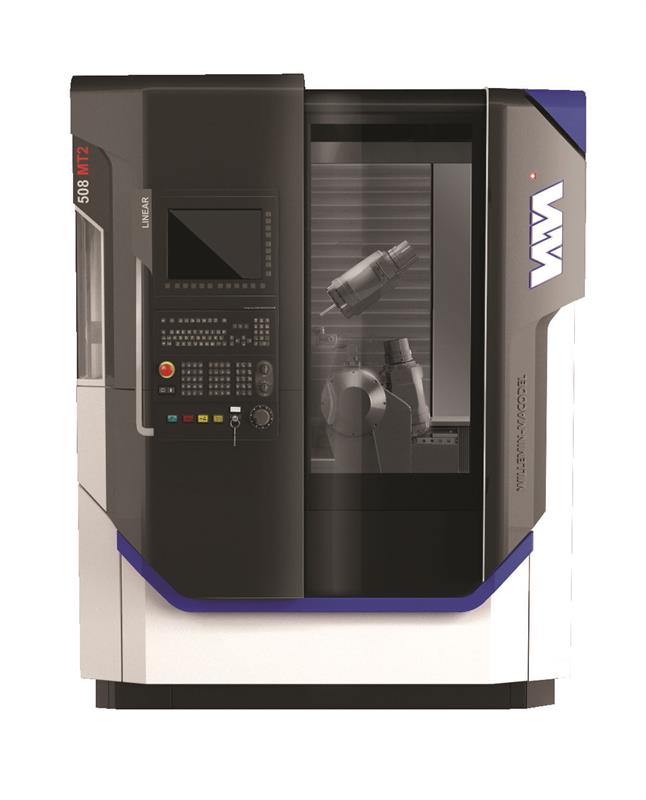With heavyweight mill-turn machines having swings up to 1,480 mm and machining lengths of 8,000 mm from WFL a prominent part of Kyal Machine Tools’ portfolio (01780 765965), the Willemin-Macodel 701S machining centre with a working envelope of 52 mm diameter by 32 mm high and able to hold part tolerances of 0.001 mm couldn’t be further away from that world of large-scale metalcutting. But its novelty doesn’t end there; the machine incorporates much unique technology.
Developed with the micro manufacturing in mind for the increasingly common miniaturised components, Kyal Machine Tools’ managing director, Simon Pollard, sees the UK market for the machine as being in the medical, fibre optics and aerospace areas. The latter is a sector that the company knows well, but this machine will be targeting very different, much smaller parts than it usually tackles, of course. Elsewhere, the new offering will see the company involving itself in new fields, says Pollard.
Launched at Europe’s biennial EMO manufacturing technology show two years ago in Hanover, the 701S (YouTube http://is.gd/5eBlY9) has been delivered within Switzerland since, with four major watchmakers amongst the clientele and a total of 20-30 units operating across that country. The machine is the culmination of 10 years of development. It was conceived in principle and initially developed at Switzerland’s EPFL in Lausanne (École Polytechnique Fédérale de Lausanne), explains Adriano Prato, area sales manager at Willemin-Macodel. Following three years’ development at EPFL, the project and associated personnel moved to Willemin-Macodel, which is located in Delémont, capital of Switzerland’s Jura canton, located between Basel and Biel.
TECHNOLOGY FIRSTS
That it took a further seven years is because of the technology incorporated within the 701S. First off, this a parallel kinematic machine; it does not have the traditional orthogonal axes of X, Y and Z. Instead, the 54 by 54 mm pallets on which workpieces to be machined are located are moved by three extending and contracting struts (a so-called delta structure), achieving virtual X, Y and Z movement. These struts are powered by linear motors, developed with an unnamed supplier, that deliver an acceleration of 5G and a maximum traversing speed of 72 m/min. And supported by linear scales that have a resolution < 10 nm, again developed with an unnamed supplier, positioning accuracy is to within 0.0002 mm, with repeatability stated as 0.00015 mm.

The 701S is of parallel kinematic design – a so-called delta structure
The machine incorporates a pallet changer having 12 positions; special fixtures can be fitted to these that support part indexing, for example, such has been employed to support watch part manufacture, allowing the component to be flipped over for complete machining.
Cutters are held in a fixed 4.1/8.4 kW, 80,000 rpm electro-spindle unit that clamps tools having a 6 mm h5 tolerance diameter shank (+0.000 /-0.005 mm), with these stored in a 36-postion toolchanger. These cutters can include end-mills, single-point tools for the turning of bosses, deburring cutters and static tools for high-tech shaping or planing. (To get the tooling that would support its efforts, incidentally, Willemin-Macodel once again had to work with a supplier.) The spindle is unclamped under hydraulic pressure, with the relaxed spindle then mechanically clamping around the 6 mm tool shank. Radial runout at the cutting edge is just < 0.001 mm at 15 mm from the spindle gauge line.
Now, notwithstanding this low tool runout and submicron positioning, with toolchanging, pallet changing, its high spindle speed and high machining feeds, you might be thinking how a closely related order of accuracy to that stated can be imparted into the workiece from the tool tip.
To the pallet first, which is one of the few standard items in the 701S’s construction. The units here are System 3R Macro 54 by 54 mm pallets (02476 538653), which have a stated repositioning accuracy of 0.001 mm.
Things get a bit more demanding for tools, however, and it is here that some very clever technology has been developed between Willemin-Macodel and an unnamed optical specialist from northern Europe. All tools are measured at their working rotation speed by an optical system, so as to obtain their true diameter and the cutting edge geometry. Apart from developing the capability to measure the tool, there is also the issue of interpreting the results. Because tools may not be free of coolant or swarf, it took time to teach the system to interpret results accurately. Overall, it took two years to develop the system.
DEMANDING PATH PROCESSING
And having measured the tool accurately, to obtain highest accuracy bores, holes or bosses, circular interpolation is employed, to a path accuracy of better than 0.2 micron.
To support this requirement demanded a fast CNC – so fast that a standard unit could not deliver. The system’s German supplier is an expert in applying industrial PCs to the field of motion control and came up with the requisite solution that samples control loops at the rate of 50 kHz (50,000 times per second). The control employs standard G-code generated by avalable CAM systems, but a tailored post-processor is required, as is the case for any machine.
Finally, onto more ordinary considerations and the machine fits within a space of a little over 1 m2 and consumes just 2 kW (average power consumption during machining operations) – the same as a hairdryer. So, highly accurate machining in a small, energy-efficient package, yes, but the cycle time benefits are, by contrast, huge.
“Depending on the complexity of the workpiece, the machining time is reduced by a factor of between three and 10. The machining of a copper electrode, for example, now takes only eight minutes instead of over an hour previously,” states a Willemin-Macodel spokesman.
With this technology, the challenge is to get companies to think differently about how they might design parts. “With such a machine, it is possible to combine the functions of what might previously have been three separate components,” the spokesman adds. It is also sometimes necessary to convince people that it is actually possible to produce something, the company highlights.

Willemin-Macodel 508MT2
BOX
High precision mill-turn
Launched at this year’s EMO in Milan was Willemin-Macodel’s 508MT2 Linear high precision mill-turn; it will similarly be available to UK users through Kyal Machine Tools. The 8-axis bar-fed or billet-loaded machine features linear drives that give a feed rate of 60 m/min (previous model, 508MT, 40 m/min). Working envelope is 300 by 200 by 380 mm in X, Y and Z. The key element, though, is high precision – parts can be made to within 0.005 mm – while the machine has some novel elements that support single-cycle machining and fast set-up.
Having 37 mm bar capacity as standard (43/51/65 mm optionally), there’s an 8,000 rpm (turning mode), 250 rpm (milling mode) horizontal torque motor-driven spindle (combined A-axis), a -45/+115° B-axis with an HSK-E40/A40/C4 spindle able to hold both static and rotary tools (up to 42,000 rpm; 15 kW; 12 Nm) plus an indexing back machining unit with three usable positions that can hold: a tailstock; a sub-spindle (C-axis); and a vice. Parts held in the sub-spindle or vice can be worked by the B-axis spindle, while the vice may also be used to support static parts held in the main spindle while the B-axis spindle does its work.
So the eight axes are X, Y, Z, A, B, C (counter spindle), U (300 mm linear positioning axis for the indexing unit (a second X-axis) and W (tool spindle rotation positioning). There’s either a 48- or 72-tool magazine, while bar can be advanced into the main spindle via a bar feed unit, or pulled using a B-axis held system or the sub-spindle unit. Courtesy of the indexing back turret, set-up time is minimal, if the relevant unit is already in the machine. It takes just 10 minutes to change a collet or chuck jaws; a few more minutes if automation unit grippers need changing. A 5-axis version will be offered, 508S2, with X, Y, Z, B and C axes. (See the 508MT2 on YouTube:http://is.gd/VMSrDu.)
This article was originally published in the December 2015 issue of Machinery magazine.




